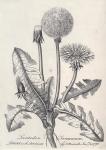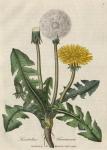003. Leontodon taraxacum. Common dandelion.

 Synonyma. Taraxacum, Pharm. Lond. & Edin.
Synonyma. Taraxacum, Pharm. Lond. & Edin.
Dens leonis, Auctorum.
Class Syngenesia. Order Polygamia Aequalis. L. Gen. Plant. 912.
Semiflosculosi Tourn. corollis ligulatis omnibus.
Ess. Gen. Ch. Recept. nudum. Cal. imbricatus, squamis laxiusculis. Pappus plumosus.
Spec. Char. L. T. calyce squamis inferne reflexis, foliis runcinatis denticulatis laevibus.
Dandelion is so very common, that a plot of ground can scarcely be seen where it does not present its yellow flowers [It has been observed that these flowers possess a certain degree of sensibility, for when under the powerful influence of the sun in a summer's morning, an evident motion of the flowerets may be discovered. MS Lect. of the late Dr. Hope.]. It is easily distinguished from the hawkweeds and other ligulated plants, by the outer calyces being bent downwards, and by the flower stalk, which is simple, coloured, shining, and unifloral: the leaves are all radical and cut in a peculiar way, forming a good example of what botanists call runcinata. The seeds, in approaching to maturity, become crowned with a fine downy feather, disposed in a spherical shape. The root is perennial and spindle-shaped, which with the whole plant abounds with a milky juice.
The young leaves of this plant in a blanched state have the taste of endive, and make an excellent addition to those plants eaten early in the spring as sallads [Withering's Bot. Arrang. p. 839.] . At Gottingen the roots are roasted and substituted for coffee by the poorer inhabitants; who find that an infusion prepared in this way can hardly be distinguished from that of the coffee [Murray's Apparat. p. 107.] berry.
Dandelion is generally considered by medical writers as the most active and efficacious of the lactescent plants; the expressed juice is bitter and somewhat acrid, the root however is still bitterer [Haller's Strip. Hel. n. 58.], and possesses more medicinal power than any other part of the plant. Taraxacum has been long in repute as a mild detergent and aperient, and its diuretic effects may be inferred from the vulgar name it bears in most of the European languages, quasi lectiminga et urinaria herba dicitur [———plus lotii derivat in vesicam quam pueruli retinendo sunt, praesertim inter dormiendum, eoque tunc imprudentes et inviti stragula permingunt. Ray's Hist. Pl. p. 244.]. Murray says, Viscidos nimirum tenacesque humores stirps solvit, et obstructa vasa reserat, eruptionem variam sanat [Murray, l. c.]: and Bergius recommends its use in obstructions of the liver, hypochondriasis, and jaundice. Its successful use in the first of these diseases is confirmed by his own experience [In hepatis morbis, praestantissima est radix haec recens, sero laftis, jusculis et apozematibus incocta. Praeclara identidem inde vidi, ubi alia sesellerunt. Saepe mihi successit resolvere duritiem hepatis cum jusculo parato e radice rec. Taraxaci et fol. rec. acetosae, in sero lactis coctis, vel in aqua, addito vitello ovi, quod jusculum quotidie per plures septimanas, immo menses, sumpserunt aegroti, propinato simul cremore tartari. Hoc regimen exoptata praestitit etiam in calculo felleo et in ascitide. Mat. Med. tom 2. p. 649.]. De Haen also gives us another instance of the same complaint cured by the same means; and we have various proofs of the good effects of the Taraxacum related by different authors, in jaundice [Van Swieten's Com. tom. 3. p. 102. and Boerhaave apud Boretium.], dropsy [Bergius loc. cit. Bonafas in Hautesierckü Recueil d'Observ. tom. 2. p. 360. Frank. Samml. t. 1. p. 226.], pulmonic tubercles [Zimmerman, vide Murray, l. c. Haller, l. c. Park. 780.], and some cutaneous disorders [Leidenfrost Dissert. de Succis. Herb. rec. p. 27. Frank. Samml. l. c. p. 126. Delius's Diss. de Tarax, aq. taraxaci per fermentationem parata: et in aliis morbis utitur. Febure Chemie. 2. p. 408. Ingreditur cum radice graminis regiam illam ptisanam, cujus formulam Ludovicus XIV. magno pretio redemit. Haller's Stirp. Hel. No. 56.].
The leaves, roots, flower stalks, and juice of Dandelion, have all been separately employed for medical purposes, and seem to differ rather in degree of strength than in any essential property: therefore the expressed juice, or a strong decoction of the roots have most commonly been prescribed, from one ounce to four, two or three times a day. The plant should be always used fresh; even extracts prepared from it appear to lose much of their power by keeping [Lewis's M. M. 273.].

